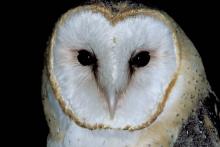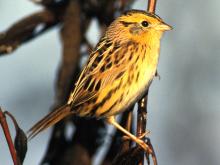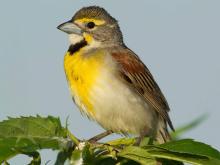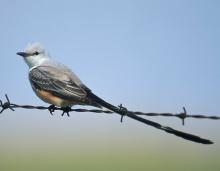Birds
Media

Species Types
Scientific Name
Tyto alba
Description
Barn owls are highly nocturnal birds with a heart-shaped face. They love to eat mice. Most nests are in grain elevators, old barns, and similar places.
Media

Species Types
Scientific Name
Aegolius acadicus
Description
The northern saw-whet owl is the most nocturnal of our owls. On the rare occasions it is seen, it is usually perched near the ground in dense cover or in the entrance of a tree cavity.
Media

Species Types
Scientific Name
Passerculus sandwichensis
Description
Savannah sparrows live in open habitat with nearby dense cover. In Missouri, we see them during migration and winters, but not summers.
Media

Species Types
Scientific Name
Ammodramus leconteii
Description
Le Conte's sparrow is one of our rarest but most colorful winter and migratory sparrows. Look for this secretive bird in brushy, grassy places such as weedy fields and prairies.
Media

Species Types
Scientific Name
Vireo bellii
Description
A drab and secretive uncommon summer resident in Missouri, Bell’s vireo is fond of dense brushy places. As with other vireos, you will probably hear it before you see it.
Media

Species Types
Scientific Name
Spiza americana
Description
Like a cross between a meadowlark and a sparrow, the dickcissel is common in prairies, pastures, and fields. Atop fences and tall weeds, it sings its buzzy “dick-dick-dickcissel” into the bright sunshine.
Media

Species Types
Scientific Name
Sayornis phoebe
Description
Eastern phoebes often build their mud-and-plant nests on the side of a house, just under a roof or other overhang. These small flycatchers repeatedly cry out their own name: “FEE-bee! FEE-bee!”
Media

Species Types
Scientific Name
Empidonax virescens
Description
The Acadian flycatcher is one of several flycatchers found in Missouri. It is a summer resident here, and like its relatives, it is much appreciated for its appetite for flying insects.
Media

Species Types
Scientific Name
Tyrannus forficatus
Description
One of Missouri’s most breathtaking birds, the scissor-tailed flycatcher captures insects in midair, then flits back to its perch. You’re most likely to see it in summer, in our southwestern prairies.
Media

Species Types
Scientific Name
Tringa melanoleuca
Description
One of the more common of about 35 shorebirds that migrate through Missouri, the greater yellowlegs is large, with a slightly upturned bill and long, bright yellow legs.
See Also







Media

Species Types
Scientific Name
Hemaris diffinis
Description
The snowberry clearwing is a moth that confuses people because it looks like a bumblebee and flies like a hummingbird!
Media

Species Types
Scientific Name
Hyles lineata
Description
The white-lined sphinx moth sometimes confuses people because it flies, hovers, and eats from flowers like a hummingbird. The adults often fly during daylight hours as well as in the night and are often found at lights.
Media

Species Types
Scientific Name
Darapsa myron
Description
The Virginia creeper sphinx moth is common in woods and brushy areas and comes to lights at night. The larvae eat Virginia creeper and grape leaves.
Media

Species Types
Scientific Name
Perimyotis subflavus (formerly Pipistrellus subflavus)
Description
Tri-colored bats, formerly called eastern pipistrelles, are relatively small and look pale yellowish or pale reddish brown. The main hairs are dark gray at the base, broadly banded with yellowish brown, and tipped with dark brown.
Media

Species Types
Scientific Name
Myotis grisescens
Description
Gray myotises are difficult to distinguish from other mouse-eared bats. A key identifying feature of the gray myotis is that its wing is attached to the ankle and not at the base of the toes. It’s an endangered species.
Media

Species Types
Scientific Name
Myotis lucifugus
Description
The little brown myotis (little brown bat) is one of our most common bats, but populations are declining. White-nose syndrome has taken a heavy toll in northeastern states. This species is now listed as vulnerable across its range.
Media

Species Types
Scientific Name
Myotis sodalis
Description
The Indiana myotis, or Indiana bat, summers along streams and rivers in north Missouri, raising its young under the bark of certain trees. It is an endangered species.
About Birds in Missouri
About 350 species of birds are likely to be seen in Missouri, though nearly 400 have been recorded within our borders. Most people know a bird when they see one — it has feathers, wings, and a bill. Birds are warm-blooded, and most species can fly. Many migrate hundreds or thousands of miles. Birds lay hard-shelled eggs (often in a nest), and the parents care for the young. Many communicate with songs and calls.





















